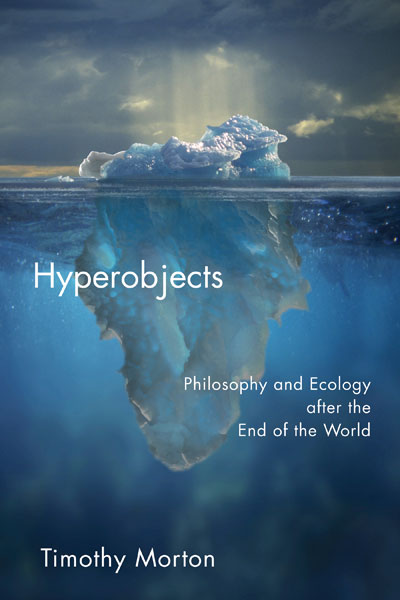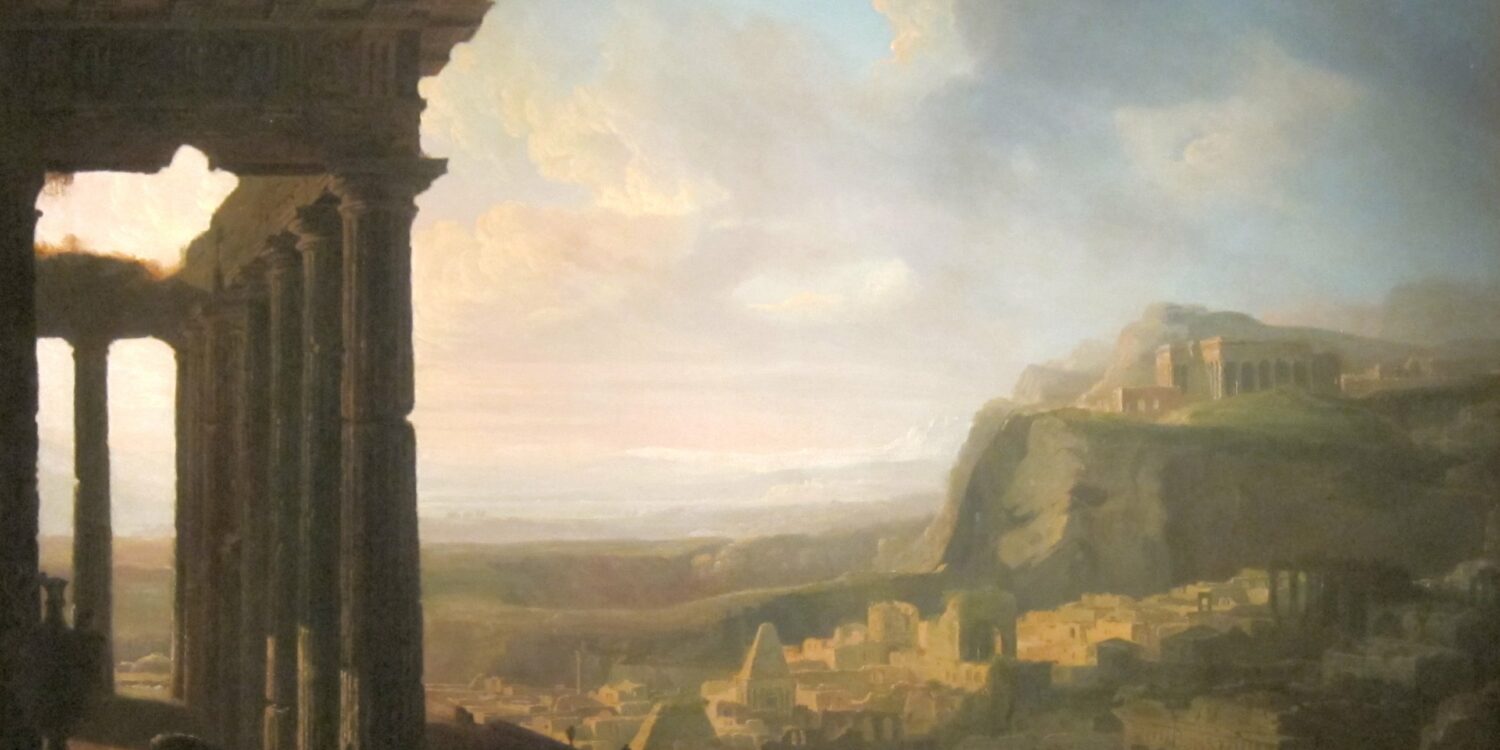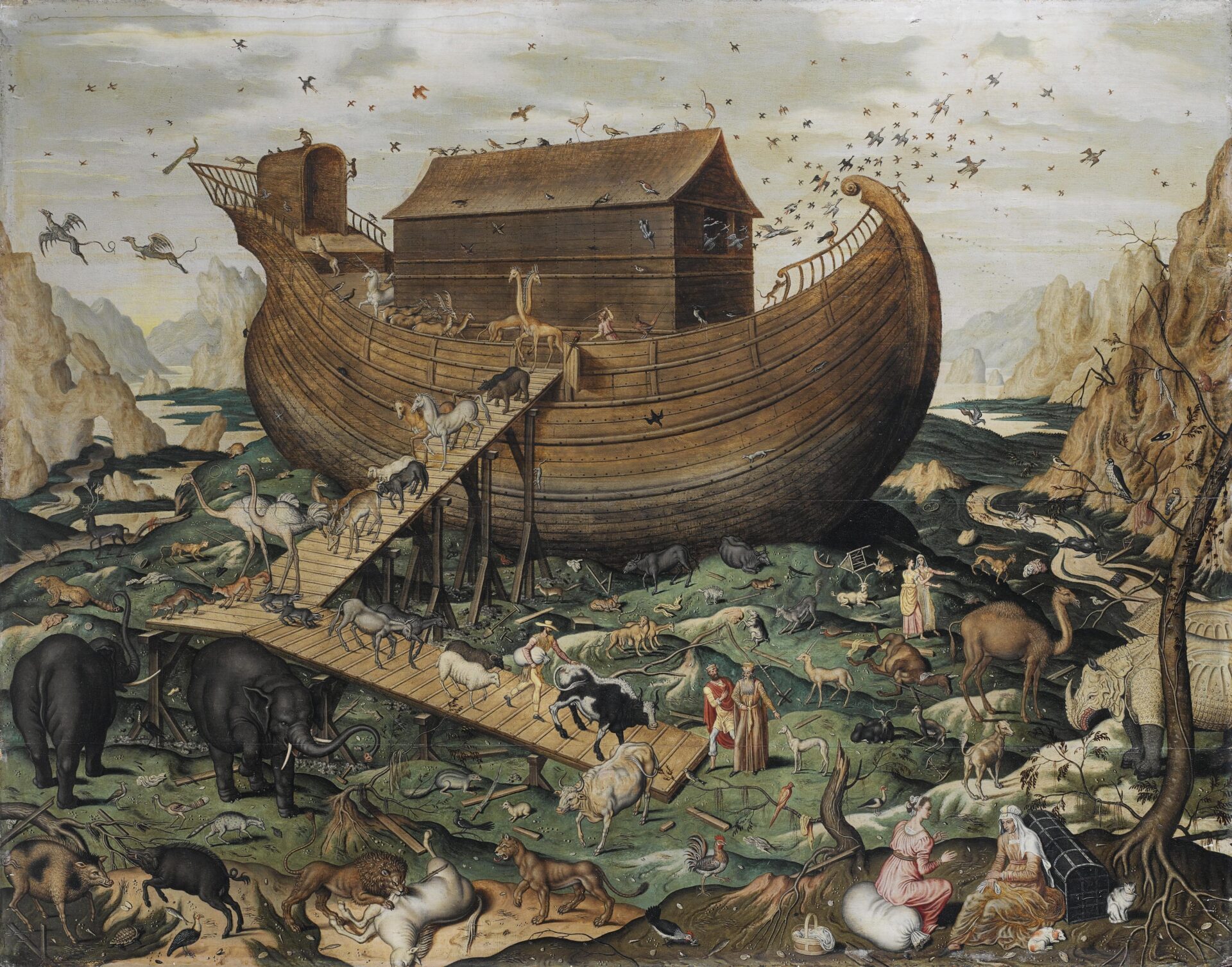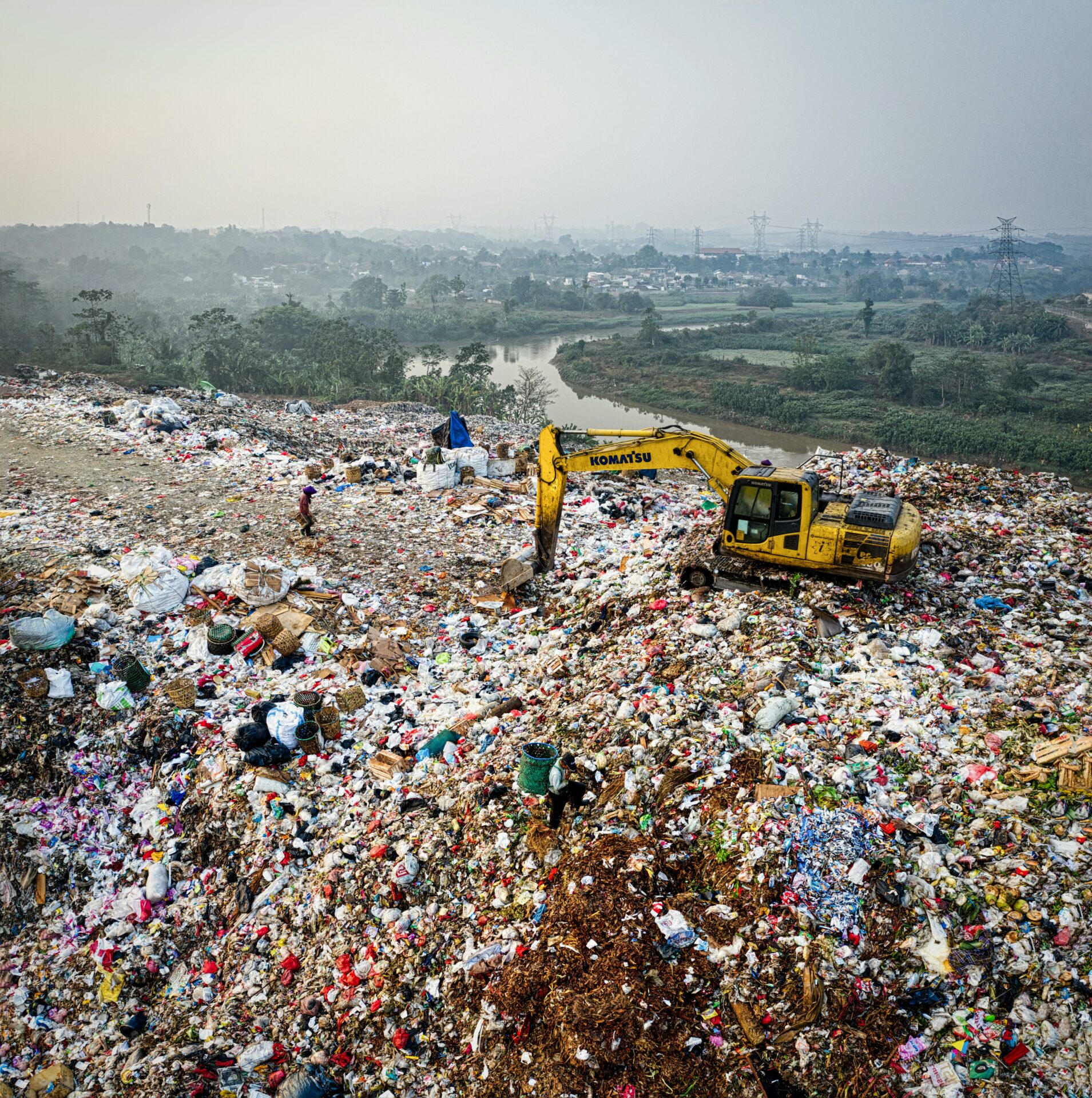This article is part of the FA special series The Climate Changed.
How useful is it to think of the end of the world? Could ongoing collapse mobilise, rather than numb?
I came across the work of philosopher Lisa Doeland and architectural historian Daniel A. Barber in 2023. The first time I heard Lisa talk was also the first time I heard of the uncanny, green fantasies and the hauntology of waste. Educated in Literature and Philosophy, she published her second book in 2023, Apocalypsofie, in which she critically dissects apocalyptic thinking by exploring notions of desire, climate change, capitalism and the Anthropocene through a lens of apocalyptic revelation.
A few months after hearing Lisa speak in Rotterdam, I attended a lecture by Daniel in the same city. Thirty minutes in, some of his questions and statements came across as weirdly familiar, as some sort of strange déjà vu. Later I understood – while at first glance Daniel’s work may seem distant from Lisa’s, the ideas that the American historian and theorist kept bringing forward revolved around the same core topic that is the backdrop of Lisa’s thinking: the climate emergency and the ways in which societies and disciplines engage with it.
The way that Daniel, who is now Head of the School of Architecture at the University of Technology in Sydney, works on the environmental dimensions of architecture and inquires into the built environment’s relationship to the climate crisis brings him, in my view, wildly close to Lisa’s work.
Essentially, I believe they are each hinting towards a different way of conceiving of the apocalypse, professional practice and social and environmental breakdown. One allows us to confront the vicious inherent injustice of our comfort. The other “embodies us as mortal beings, with all the suffering that entails” (these are Lisa’s words).
Moved by these ideas and a genuine (almost foolish?) wish to witness a conversation between them, last summer I approached them. I proposed a double interview, they said yes.
Now it’s a relatively uncloudy morning in Amsterdam, after-work-drink time in Sydney and a very hot day in Ibiza, where I am. Lisa and Daniel just joined the Zoom call we set up months ago, and I’m excited. Something tells me I will do little but throw in a few questions here and there, steering the discussion almost in the shadows as Lisa and Daniel alone run through my whole interview plan with me mostly listening and thinking – some of my thoughts are reflected here too – with my mic turned off.
Lisa asks us if we can hear her well, apparently there’s construction work next door. With a fitting metaphor of a seemingly never-ending building boom, we start.
Nuria Ribas Costa: What does ‘apocalypse’ mean to you?
Lisa Doeland: The first things I think of are the apocalyptic movies of course. I see planet Melancholia crashing in, I think of Don’t look up… all spectacular, all-encompassing. But what I’ve been trying to do recently is explore whether the notion of apocalypse is a helpful prism to look through at the climate catastrophe.
NRC: Is it?
LD: What I argue is that we should abandon the idea of the apocalypse or the end of the world as something yet to happen, avoidable; and instead, think of it as something unequal, slow maybe, already taking place.
I recently realised that my take on the apocalypse is akin to Timothy Morton’s hyperobject – something we find ourselves engulfed in, something that sticks to us, that we’re part of; but from which we try to find some distance and get a feel for, so that it stops being diffuse.
I think we need to define the apocalypse as a revelation (a dark revelation perhaps) of the climate catastrophe that is unfolding, to help us get a sense of it.

Hyperobjects are entities of such vast temporal and spatial dimensions. They defeat traditional ideas about what a thing is in the first place. Morton argues that the ‘hyperobjects’ of the Anthropocene, like global warming, climate or oil, are “massively distributed in time and space relative to humans.”
Cover of Hyperobjects, by British Philosopher Timothy Morton (University of Minnesota Press, 2013).
Daniel unmutes himself and begins slowly.
Daniel Barber: A lot of my thinking plays in quite well with your framing. I focus on the notion of an end of the world as the beginning of another one. Using terms like aftermath, I try to convey a sense of drawing a line, of saying “something has happened” or “is happening” and there will be some sort of before and after. I think this is something that we collectively struggle with in relation to the climate crisis.
NRC: How does this thinking help?
LD: I use the interpretation of Noah by German philosopher Günther Anders as a way to explain how our current present points at a specific future, to say “if this is your present, that will be your future, it will be dire and inescapable”; in order to prompt action to make it not come true.
This seems to be very difficult to understand. Often in public debates in the Netherlands, I am called a fatalist, but then people get confused because they do not understand how I can be engaged in activism. If I were a fatalist, I would never take to the streets.
To me, it’s important to really engage with the idea that the status quo will lead to collapse (another problematic term, but that’s another story), in order to overcome feelings of powerlessness, helplessness, and work towards alternatives. My whole argument is that we should allow for another end of the world to be possible, and I am actually quite hopeful about this.
DB: This is very useful, especially the triangular relationship apocalypse–collapse–hope.
I like to question the use-value of the apocalypse. I try to emphasise that the premise of apocalypse is not collapse in the sense of “giving in” but rather in a clear indication that the future will not be like the present, and so we need to decide what we want it to be, how to shift the status quo. In that sense, this idea of the use-value or agency of the apocalypse to understand how anticipating collapse offers a different set of design methods, how it repositions what architects and designers do, how it helps reconsider the “social project” of the profession.
I have been working on Arundhati Roy’s framework of “the pandemic as a portal,” on the halt on carbon emission as a basis for a different world. But if the portal was there, it feels like it might have closed.
LD: I really like you mentioning the portal and the pandemic. I’m reminded of Marco Armiero’s essay Wasteoscene, in which he argues that the pandemic opened different ways of thinking about the situation we’re in. The Wasteoscene is an era dominated by wasted relationships, by the wasting of people, animals, ecosystems; relationships through which we, too, become disposable, where some beings become more important than others.
And I agree, the pandemic was a portal, but then again – don’t we have other portals?
NRC: Do we?
LD: If we pay attention, there are so many of them. The fact that there’s microplastics in my body, for example. That my body, too, is a container of waste, while of course, waste is not distributed equally. Other bodies are way more of a sacrifice zone than mine. If we start looking, there are many portals to be found, but it’s hard to keep them in sight. We tend to not want to see, because it’s painful or uncanny.
DB: This is helping me think about something I’ve shaped only abstractly – isn’t the role of research and the academy to identify these portals?
(I wonder: is Daniel’s work on facades and windows perhaps a metaphor of this search for possible openings?)
DB: At CAPAS I focused on trying to articulate for architects the effects of “having crossed a line,” arguing that the built environment today cannot operate without recognising that this line of the climate crisis has been exceeded.
But how do we articulate this aftermath, this post-condition? What are we post-? where did the line get drawn?
LD: There’s this documentary by Josh Fox How to Let Go of the World and Love All the Things Climate Can’t Change (2016) that I sometimes watch with my students. In the film, several scientists talk about the consequences of climate change, presenting thresholds: “To make sure Greenland’s ice sheet does not melt we need to stop doing this by 2017; and this by 2020.” Watching the documentary now, you realise that we’re living past all these thresholds already.
And now what?
Lisa and Daniel laugh briefly. The Green New Deal, carbon capture, electric vehicles, renewable energy and all sorts of other technologies timidly enter the conversation.
DB: Holly Jean Buck uses a fitting notion to address carbon capture and the whole net-zero-by-2050 discourse, seeing it as a ‘moral hazard’. While these technologies are great, and can certainly contribute to reducing emissions, if their deployment allows you to think that burning fossil fuels is still ok, it’s not going to help.
I bring forward the notion of progress as a sort of freaky trap. Through this apocalyptic lens, progress reveals itself to be, in Daniel’s words, “some kind of huge ‘whoops, I guess we didn’t really know what we were doing.’”
DB: The value systems associated to this mainstream idea of progress are explicitly detrimental to our future. There’s a clear sense of progress for some and not others, a confirmation that all these glass and steel towers will continue to be refuges for those that can afford them and air condition themselves; while the rest will boil and suffer.
So progress becomes a kind of bad, dangerous joke, Daniel argues.
LD: Progress makes me think of ruins; of the fact that we need to focus on the ruins. Instead of moving forward with progress on our minds, we should instead look back and allow ourselves to see the waste, to see the ruins this forward pulse amounts to.
Daniel nods.
DB: Back in the US I frequently taught an essay by Julian Brave NoiseCat, a Native American Secwepemc and St’at’imc writer. He argues: “We have been through this. This total end of our world happened to Native Americans already.” Every practice that fulfilled them and sustained their cultural worlds was suppressed violently and in effect disappeared, not to mention the majority of their population.
Lisa nods.
LD: Within this permissibility to waste, I would argue that engaging with the experience and knowledge of First Nations is engaging with peoples that have been wasted in the past.
(Waste, suppression, silencing, ruins. Ruins, ruins, ruins…)
NRC: This is making me think of the work of Anna Tsing. Should we be looking at what remains through the lens of what disappeared already? What do these voids tell us about the comfort we maybe cannot afford?
LD: I think the arts of living in the ruins of capitalism that Tsing explores would also be arts of letting go of comfort, because living in the ruins is not a comfortable thing, and it’s hard to design for it. I would like to hear your thoughts on this, Daniel, because design is… well, we want to design to last, right? Is there a way to draw on Anna Tsing in architecture?
Lisa and I look at Daniel. He nods. Unmutes himself.
DB: Hm… In some ways waste has been of great appeal to many designers, asking how valuable can seemingly wasted parts of buildings be. But there’s a connection between this and progress: in the name of progress, we’ve built future ruins: glass-sealed office towers, for instance. These buildings are not ruins yet, in the same way a Mediaeval castle was not built as a ruin, but the socioeconomic conditions that supported them, we see now, are in the process of collapsing.
So the question is: how will these air-conditioned towers be viable after fossil fuels? Most of them will suffer, some of them will fail structurally, many of them will be covered in mould once humidity levels cannot be managed mechanically, in many of them humans won’t be able to breathe. Do they become ruins? Do they become waste?
NRC: How do we define ‘ruin?’ What do ruins say about comfort?
LD: Comfort relies on immunisation. We need walls to keep the bad things out.
NRC: Can we though?
DB: What the social project of mechanical comfort has done is produce waste. We’ve been building to condition ourselves inside with complete disregard for what happens outside – air conditioning is just a displacement of heat.
Lisa nods repeatedly, moves excitedly, unmutes herself.
LD: This is exactly where we meet – I conceptualise waste as something that only seemingly disappears.
(But in this virtual room we all know: it never disappears.)
LD: We rely on the existence of an “away,” where all this heat, waste, everything, goes to and stays in. But it never disappears – it comes back.
DB: Could we define progress perhaps as this “capacity to make things disappear”, which is to say – there’s a wildly uneven condition across the globe and across time, one in which some people have been able to hide the externalities that allow them to live in comfort, others have not.
Lisa nods. I try to speak, but she starts a point. Daniel laughs as I’m left thinking about that “away” being so many different places across the world.
LD: This capacity to hide relates again to the apocalypse – apocalyptic revelations are like returns of the repressed.
Daniel nods. (I’m thinking: are these returns of the repressed what discomfort looks like?)
DB: What I think about when I think about discomfort is, to put it bluntly, how those that have lived over-carbonised lives deserve to suffer, have some capacity to suffer. We have benefited from these inequities, from this capacity to make externalities disappear. Discomfort is the recognition that our lives have been possible by abusing resources and others – and that we can provide compensation.
LD: This summer, during the forest fires in Rhodes, tourists fleeing the island complained that they felt like refugees. I hoped this shared sense of vulnerability would be a portal, but I don’t think it sank in yet.
She asks Daniel if he feels optimistic about this potential portal, but he shakes his head.
DB: there are so many people not paying attention. When do these events stop having an episodic nature? The only way I’m optimistic is that things are going to get so abysmal that people are really going to have to change what they’re doing. But then again, we also know there’s so much work being done to push that threshold away – to hide collapse from those who are shepherding it in.
LD: Yeah… until it breaks!
Concerned smiles.
LD: I’m no optimist either, but I do have some kind of hope that when we cultivate ways of estranging ourselves from certain behaviours, this might open up some kind of door.
DB: Absolutely, and there’s a distinction between optimism and hope. Evidence of transformation being possible gives us hope as it feeds a desire to cultivate new practices.
LD: Perhaps this can become an active hope, so that we constantly ask ourselves why and how the conditions have changed. Why have all the insects gone? Why didn’t we notice they disappeared until a study showed it? Why are we so estranged from our environments that we don’t notice these changes taking place?
Daniel nods in agreement.
LD: Because we know that the environment has been shaped by fossil fuel capitalism, we need to make sure we stop all these dreams to hold on to it a bit longer.
DB: Yes, we have to wake up from those dreams. And wake others up, too.
As the conversation comes to an end, we talk about the times ahead (as if we hadn’t enough already,) the right to the future (whose right?), Jacques Derrida’s ‘survie,’ extinction, exhaustion, over-carbonised happiness, business as usual and Daniel’s physical reaction to the great aspiration of a colleague of his:
DB: She used this phrase: “How can architects see as part of their obligations that of being good ancestors?” and I was just like “Wow, we are so far away from that.”
(But how to get there? How to even begin to get there? Both Lisa and Daniel work in universities, have teenage daughters and engage in climate-conscious circles. How to talk about the end of this world to students, colleagues, daughters?)
LD: We need to smash the system they have come to depend on and love, because that has led to disaster and will lead to more disasters in the future; so it just has to go.
DB: And our role is to open those portals, welcome the thresholds, and encourage the psychological condition that will allow people to accept the transformations that are coming.
(Are we ready to allow for another end of the world to be possible?)
Lisa Doeland is a philosopher. She lectures at the University of Amsterdam and Erasmus University College on the climate crisis, green ideology, the Apocalypse and the underground, amongst others. In her PhD she explores the many and uncanny ways in which we are haunted by waste. How does the spectre of waste force us to rethink dreams about recycling without remainders within a circular economy? Her essays have been published in many Dutch magazines and journals. Apocalypsofie (2023) is her most recent book.
Daniel A. Barber is Professor and Head of School Architecture at the University of Technology Sydney. His most recent book is Modern Architecture and Climate: Design before Air Conditioning (2020). His current research on architecture and sufficiency is supported by a fellowship at the Centre for Apocalyptic and Post-Apocalyptic Studies at the Universität Heidelberg, the British Academy, and the Guggenheim Foundation. Daniel co-edits the series “After Comfort: A User’s Guide” on e-flux architecture, commissioning texts, projects and experiments focused on how we will live indoors without fossil fuels.


